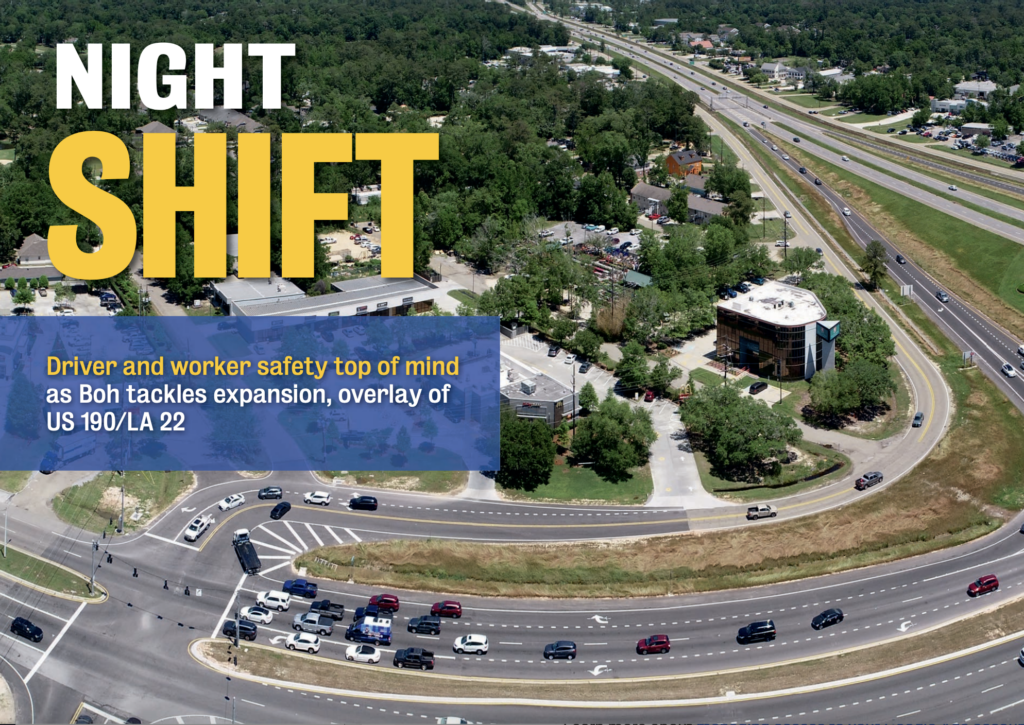
Traffic counts have steadily increased along US 190/LA 22 in Mandeville in recent years. More travelers have led to new businesses seemingly crop up overnight, and retail and residential neighborhoods tightly border the highway in many locations.
To support the rising volume of travelers, Boh Bros. Construction recently assisted Louisiana DOTD and the City of Mandeville in a jointly managed $10.3 million project to expand and overlay a section where the two highways converge. Over three phases in 2023-24, the company worked nights to widen ramps, frontage roads, and driving lanes using sand, limestone and asphalt, then milled and overlaid the existing surfaces across the entire site.
There was also an extensive electrical phase, necessary to relocate traffic signals at the intersection, along with the reconfiguration of concrete medians and installation of new cross drains. Upon completion, the 25- to 30-person Boh team had placed some 13,000 tons of Level 2 Superpave asphalt to create the newly expanded road sections.

Complex Reality
On paper, this was a straightforward job. Boh was to widen the driving surfaces, ramps, and service roads as part of Phases 1 and 2, then mill and overlay all existing surfaces during Phase 3.
In reality, the US 190/LA 22 project was far more complex. “We raised a lot of questions during preconstruction,” says Stephen Alexander, group manager in Boh’s Asphalt Department. “There were a dozen or so things in the plans that needed to be clarified before we could even begin.”
For example, the plans called for temporary traffic signals to be erected since existing signal footings fell in the path of new road sections, “but they didn’t adequately describe how that was to be done,” Alexander says. “We had to iron that out at the start.” The plans also called for drivers to be diverted to the new lanes following the completion of Phases 1 & 2, but a 2-inch drop-off between pavement surfaces would have created a driving hazard. As a solution, the project team opted to raise the asphalt to match the existing lanes before diverting traffic.
Much of the specialty work had to be performed between phases, so communication was essential to ensure that subcontractors were staged and ready when needed. To kick off the project, Boh’s pipe subcontractor placed cross drains and removed existing traffic signal poles, then made a 31-inch-deep “cut” for the new road sections.
From day one, the Boh team knew that having such a deep cut adjacent to live traffic represented a potential safety hazard. A heavy rain event could also have turned the site into a bathtub. “It was critical that our subcontractor got the sand base placed as quickly as possible,” Alexander says. “We also installed vertical delineators to make the work area highly visible to drivers.”
With the 1-foot layer of sand in place, the Boh team then placed 10 inches of crushed limestone, 5 inches of asphalt base, 2.5 inches of binder and 2 inches of wearing course for each expanded section. “We began on the western end of the site and worked our way east,” says David Quebedeaux, project manager.
Between phases, subcontractors reconfigured median islands, and installed new electrical components and cross drains. When issues arose, the Boh team would quickly devise solutions to keep the project moving. “Our surveyors laid out one of the service roads and found the edge of it ran through the middle of about 500 feet of open ditch,” Quebedeaux says.
Boh quickly submitted an RFI and met with the project engineer to devise a solution, ultimately choosing to install a culvert rather than relocate the ditch. “We didn’t want to stop the project as we worked through the issue, so we continued building the rest of the job,” Alexander says. “We opted to just skip over this one service road, and then once everything was approved, we went back and wrapped everything up.”
Under Cover of Darkness
Given the volume of traffic on US 190/LA 22, it would have been nearly impossible to perform the work during the day and still meet the deadline. To mitigate major disruptions to traffic and the schedule, Boh decided to perform the work at night. But while working from 8 p.m. until 6 a.m. alleviated the traffic issue, it created other challenges inherent with night work. “I don’t care how much portable lighting you put on a job, it’s never enough,” says Tim Dupre, Boh’s general superintendent. “And with asphalt work, you’re constantly moving. That requires a lot of lighting.”
And since the rock supplier did not operate at night, the Boh team had to find property nearby to stockpile materials. “They’d haul rock during the day and pile it up for us,” he adds. “That made the process easier.”
Anthony Harrison, Boh’s asphalt superintendent, would go over the Job Safety Analysis (JSA) at the start of each shift to ensure that everyone knew the game plan for the night. The team also used a GPS-based “Fleet Watcher” tracking system to monitor the location of the 10 to 13 asphalt trucks hauling asphalt from Boh’s France Road plant to the jobsite.
“We’d call the plant and give them a loadout time, and once they started, we just looked at our phones to determine exactly how far away they were,” Harrison says.
A smooth transition between night and day shifts was essential, so there was a heightened level of communication between the superintendent, project manager, transportation manager, operations engineer, construction manager and asphalt plant team. “The whole group had to be in sync with one another,” Quebedeaux says. “Everything had to be staged and ready for the next night. The site crew would get off at 6 a.m., then everyone at the France Road office would get in at 7 a.m. We had to provide them with a detailed daily report, letting them know what happened the previous night and what our game plan would be the following night.”
To keep the rest of the US 190/LA 22 project team in the loop, Boh managers would meet with DOTD, the City of Mandeville and project engineer every other Tuesday.
Through it all, safety would always trump schedule. “We knew there was going to be a lot of traffic, even at night,” Alexander says. “Because of that, all eyes were on this job. Having the proper lighting out there, making sure the guys were wearing the proper visibility vests, making sure that the lane closures were set up properly, that we had police presence out there etc. … there were quite a few things to track.”
Heat was another safety concern. Even at night, the temperatures in August 2023 rarely dipped below 90 degrees, so supervisors provided workers with access to water and sports drinks and reiterated the importance of staying hydrated. “Safety is number one at Boh, both for our workers and the public, so we made sure our lane closures were executed correctly, the delineators were clearly defined, and that any excavations were properly backfilled,” he adds.
“No matter what we were doing, we communicated constantly and had everything in place when it needed to be.” Our goal at the beginning of the project was to deliver a safe, high-quality project for both the owner and the traveling public, and our goal was accomplished.

Recent Comments